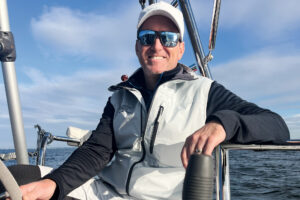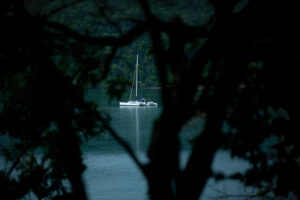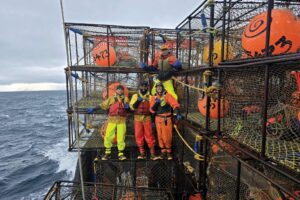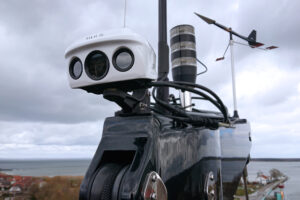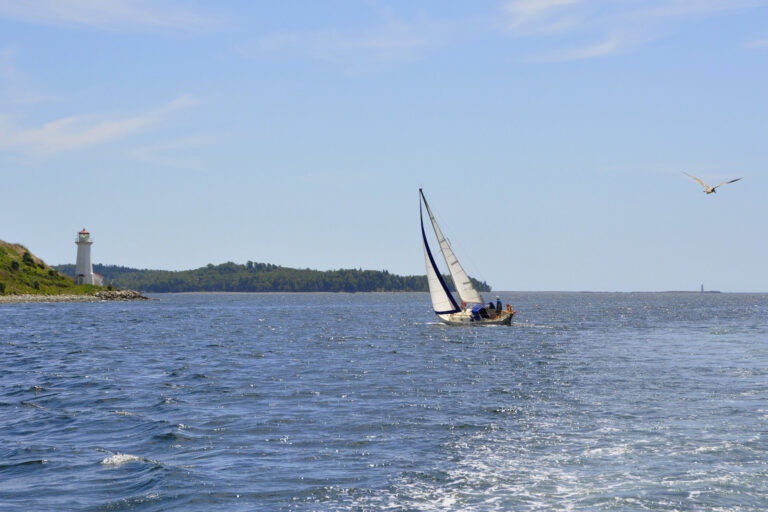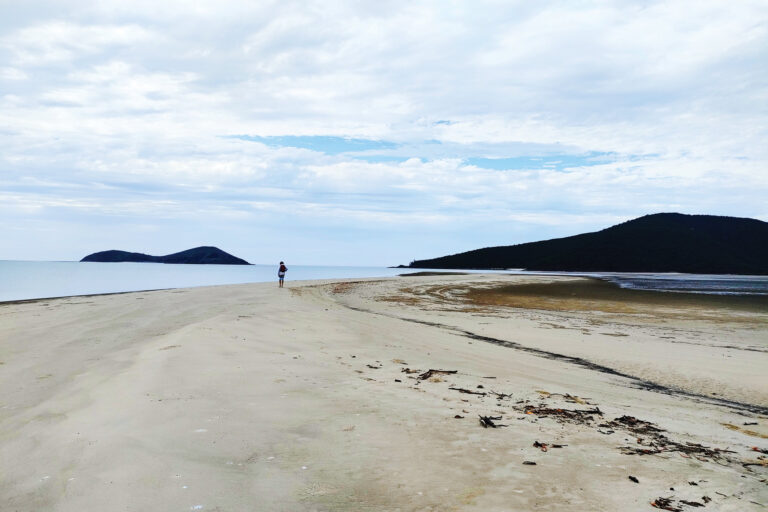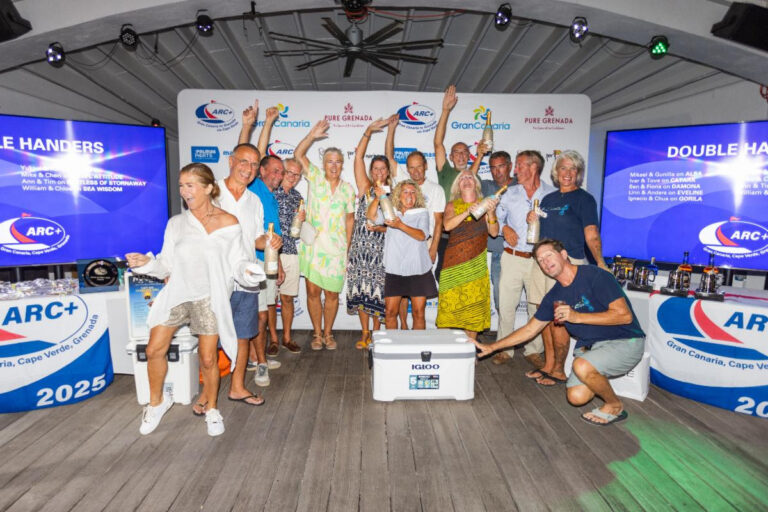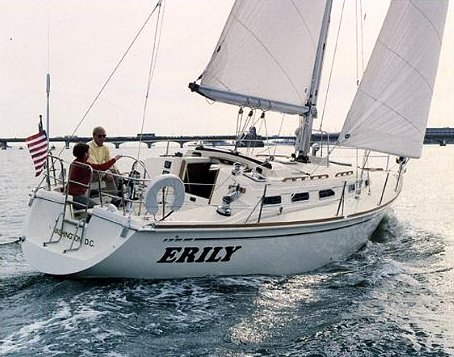
In 1989, Bill Shaw, thinking to improve on the overmarketed “cruiser/racer” theme by emphasizing the “cruiser” aspect, developed the Pearson 38. Although Pearson Yachts closed its doors in 1990, the Pearson 38 had a short but successful run among Pearson sailboats. In 1996, the Cal-Pearson Corporation reintroduced the Pearson 38 but launched only three boats before it, too, closed up shop.
The Pearson 38 has a flat sheer, a pronounced bow overhang, and a sugar-scoop stern with step-through transom. Low cockpit coamings and clean, appealing cabin-house lines offset the generous freeboard. Ample beam enhances both interior volume and form stability. Below the waterline, the boat has an externally mounted wing keel and an elliptical rudder. The solid, hand-laid-fiberglass hull and the balsa-cored deck are joined on an outward-facing flange. The joint is sealed with a polyurethane adhesive, bolted on 8-inch centers, and protected with a vinyl rubrail.
Belowdecks, the forward cabin features an island double berth, a hanging locker to starboard, and a locker to port. An opening hatch and two opening portlights allow for plenty of light and good ventilation. A solid teak bi-fold door opens from this cabin into the saloon, where a port-side settee and L-shaped seating around a centerline drop-leaf table to starboard easily seat eight for meals. The dinette also converts into a good-sized double berth. Aft of the port settee is an aft-facing navigation station and a wet locker.
The head compartment is located to port and aft of the companionway steps. It has a stainless-steel sink and a curtained-off shower area. A hinged seat covers the forward-facing head to keep it dry when the shower is in use.
Aft of the dinette and near the companionway, the L-shaped galley is fitted with an 8-cubic-foot icebox, a stainless-steel double sink, and a gimbaled two-burner propane stove with oven.
Aft of the galley is a second cabin with an athwarthships double berth that extends beneath the cockpit. A large hanging locker with built-in shelves provides stowage; an opening hatch and two portlights admit light and air.
The 38 is rigged as a masthead sloop with a keel-stepped spar, double spreaders, internal wire/rope halyards, and jiffy reefing. Standard equipment included a full-battened mainsail and a roller-furling headsail.
Under sail, the Pearson 38 tacks easily through 90 degrees and should make 6.5 knots in around 10 knots apparent. Its light-air performance is above average, and with judicious reefing, it can handle some pretty heavy air.
The Yanmar 3GM30F is beneath the galley sink. Accessibility, except for the oil dipstick, is near excellent. A panel in the cabin sole lifts out to reveal the stuffing box.
While well constructed, Pearson 38s aren’t bulletproof. Because they’re now two decades old, expect some deficiencies due to age and, possibly, to poor maintenance. Balsa-cored decks are always a potential source of problems, and portlights are prone to leaks.
The Pearson 38 is a solid, easily handled, and light-footed coastal cruiser that can accommodate two couples in comfort and safety. Its sailaway price 20 years ago was about $150,000. Expect to pay around half that for an average offering.
Review # 2
Cruising World’s Boat Of The Year judging is meant to evaluate new additions to the sailboat market. But stepping aboard the Pearson 38, we were impressed as much by what’s old as what’s new about the boat. The 38 offers ample measure of both.
What’s old is the legacy. Going back to the 1959 New York Boat Show when the fledgling Pearson company introduced its 28-foot Triton is to return to the cradle of production fiberglass-boatbuilding history. Much as Henry Ford revolutionized automobile production with his Model T, taking the car from the realm of rich-man’s luxury conveyance to Everyman’s utility vehicle, Pearson built 1,000 Tritons and myriad other successful boats for three decades at a price that beckoned whole generations of new sailors toward the water. But the vagaries of the market took their toll, and in 1990 Pearson Yachts went out of business, ending the Pearson line.
Until last year, that is, when a group of nostalgic investors returned to some of the designs and molds that were most successful in the 1980s and resurrected the Pearson name. Called the Cal-Pearson Corporation, this new company hopes to turn out 50 boats a year. The 38 was the first one launched; a 34 and a 39 are soon to follow.
We sailed the 38 on a light to moderately breezy October morning off Annapolis. This “new” boat, taken from a 1989 mold in which 21 previous hulls were laid up, features many refinements on a popular theme. Her sprightly ride harkened back to the coastal-oriented, racer/cruiser approach of her predecessors: We tacked easily through 90 degrees, making 6.4 knots in just under 10 knots apparent. Wind abeam, she topped out at 6.1 knots; with wind quartering, she made 5.8 knots. Running rigging is deftly organized, with main halyard, reefing lines and mainsheet led under the dodger into the cockpit. Lewmar 54 self-tailing primaries are standard, as is Harken roller furling for the jib.
The solid-FRP hull is laid up with osmosis-inhibiting vinylester resin below the waterline and polyester above. The deck is cored with end-grain balsa, except in high-stress areas where plywood is used for support; it is bolted to an outward-turned hull flange every eight inches and sealed with 3M 5200 polyurethane adhesive. The underbody on this boat features a wing keel with a modest 4’9″ draft, but deeper-draft options are available.
Changes to hull number 22 mark a shift toward the cruising end of the racer/cruiser spectrum. The new line of 38s features a step-through transom for more convenient boarding. The forward anchor well, formerly a shallow pan, has been deepened and made accessible from the interior to meet a cruiser’s anchoring demands more realistically. A dedicated propane locker with overboard vent has been added in accordance with ABYC recommendations. The toe rail was heightened by one third to improve safety underway.
Stepping below, you are greeted by a light, open interior. Ample ventilation is provided by a molded-in Dorade box, four opening hatches, and 10 opening ports. The boat’s only head is situated just to port and aft of the companionway steps; hence, it doesn’t take up any space forward of the main saloon’s aft bulkhead. A nav station and settee complete the port half of the main saloon; they are designed so that the navigator sits on the aft end of the settee facing aft to use the chart table — another space saver.
To starboard, an L-shaped galley with gimballed two-burner propane stove and oven occurs just outboard of the companionway steps. It also features an eight-cubic-foot ice box and stainless-steel double sink. Turning aft from the galley, you face a stateroom with a six-foot-long double berth that extends toward the transom under the cockpit. Forward of the galley is a U-shaped dinette. The fixed portion of the dinette table abuts the keel-stepped mast; a seat against the cabin’s forward bulkhead drops down to facilitate getting around the table. A drop-leaf section serves the port settee.
The forward cabin features an island double berth plus hanging locker. A small freshwater tank is located under this berth; a larger one appears under the aft-cabin berth. For maintaining mechanical systems, the boat is laid out well. No cabin headliner is installed, so the back side of any deck-mounted gear is easy to work on. The 38-horsepower Yanmar auxiliary is mounted below the galley sink — an arrangement that renders the engine noisy, but very accessible. Belts are easy to reach once you remove panels in the dinette; easy access to the oil-fill cap is by way of a hatch at the port side of the sink; the engine-oil dipstick is behind a panel on the sink’s aft side. Lifting a hatch in the cockpit sole reveals one of the most accessible stuffing boxes you’ll ever see aboard a sailboat in this size range.
The prototypes for the new Pearson line are being built under contract from Bristol Yachts, in Bristol, Rhode Island, with a conscious attempt by the builders to bump these boats up a step on the quality ladder from previous Pearsons. The interior of the new 38 is built with finely finished cherry paneling, for example, and all the deck hardware — hatches, ports, winches, travelers — is high-quality Lewmar gear. Construction bonuses, such as recessed genoa tracks and added midships chocks and cleats, round out the list of improvements. Sail-away price for this boat is $149,900. In terms of design innovation, there’s nothing fundamentally new here, but perhaps what’s new is not necessarily what’s best. What we have here is a fresh start for a well accepted boat whose production run a decade ago happened to be interrupted. The Pearson 38 is a solid, light-footed cruiser aboard which one or two couples should expect to have a wonderful tour of any far-reaching coastline.
Specs
Pearson 38
LOA 37′ 6″ (11.43 m.)
LWL 29′ 7″ (9.02 m.)
Beam 12′ 4″ (3.76 m.)
Draft 4′ 9″ (1.45 m.)
Sail Area (100%) 665 sq. ft. (61.8 sq. m.)
Ballast 6,050 lb. (2,744 kg.)
Displacement 15,175 lb. (6,882 kg.)
Ballast/D .40
D/L 262
SA/D 17.4
Water 100 gal. (379 l.)
Fuel 22 gal. (83 l.)
Engine 30-hp. Yanmar diesel
Designer Bill Shaw

